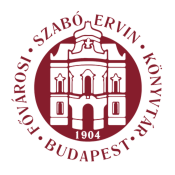Gábor Eszter: Andrássy Avenue – Our Budapest (Budapest, 2002)
renovations carried out in the 1980s. (Operated by electricity, the new gear is more modern, but it is less reliable.) An apartment block was planned for the area opposite the Opera House (No. 25 Andrássy út) between Dalszínház utca and Hajós utca, originally consisting of three plots, by the pension fund of the Hungarian State Railway Company. The designs were drawn by Gyula Pártos and Ödön Lechner, who had newly returned from being employed for years in France. Bearing the marks of a strong French influence, this building has an architectural character distinctly different from the Italian neo-Renaissance style of the Opera House and the entire street. The alternative design is indicated by the corners, which are reminiscent of donjons, the peculiar, at points triangular, design of the balconies, the shape of the window frames and the now unfortunately missing turret tops. Despite these stylistic differences, Lechner went out of his way to form the mass of his building in harmony with the Opera House across the street. Similarly to the latter, his work features a middle projection between two withdrawn side-wings to create a sense of spaciousness. Besides alluding to the Opera House, the loggia on the ground floor of the projection offered an ideal area for a sidewalk café with its five apertures. What is perhaps the friendliest, most inviting, photograph of Budapest made at the turn of the 19th and 20th centuries features the Drechsler Café, which was located right here. After 1945, the State Ballet Institute was housed in the former café, which occupied more than one storey. The artists of the Opera House also liked to rent flats in the block. The by now abandoned building stands deserted awaiting the next owner to destroy the surviving valuable elements of the interior. What can be hoped for is that the exterior will at least remain intact. A row of apartment buildings stretches all the way to Nagymező utca. At the corner of Hajós utca (No. 24 Andrássy út), where the Goethe Institute is today with the Eckermann Café on the ground floor, used to be the Opera Café on one side and, on the other, an establishment, perhaps a mere pub, called The Three Ravens, recalled today by a plaque on the side of the entrance. This haunt of the poet Endre Ady was commemorated by the writer Gyula Krúdy. "Ady liked to work in the recess, separated by some boards and hung with tobacco-coloured curtains, whose wine-stained frloor had seen the socalled religious disputes of yore and the pub fights ofr more recent times. While Ady was working. Béla Révész was sitting at a table near the separated cabinet' welcoming the poet’s disciples along with renegades, fools and saints, reformed drunks and pseudo-drunks in their elastic-sided boots arriving under cover ofr darkness from all over the city on hearing the news that Ady was writing his Sunday poems. But nobody dared enter the poet’s sanctuary." (The Nights of Endre Ady). 22
